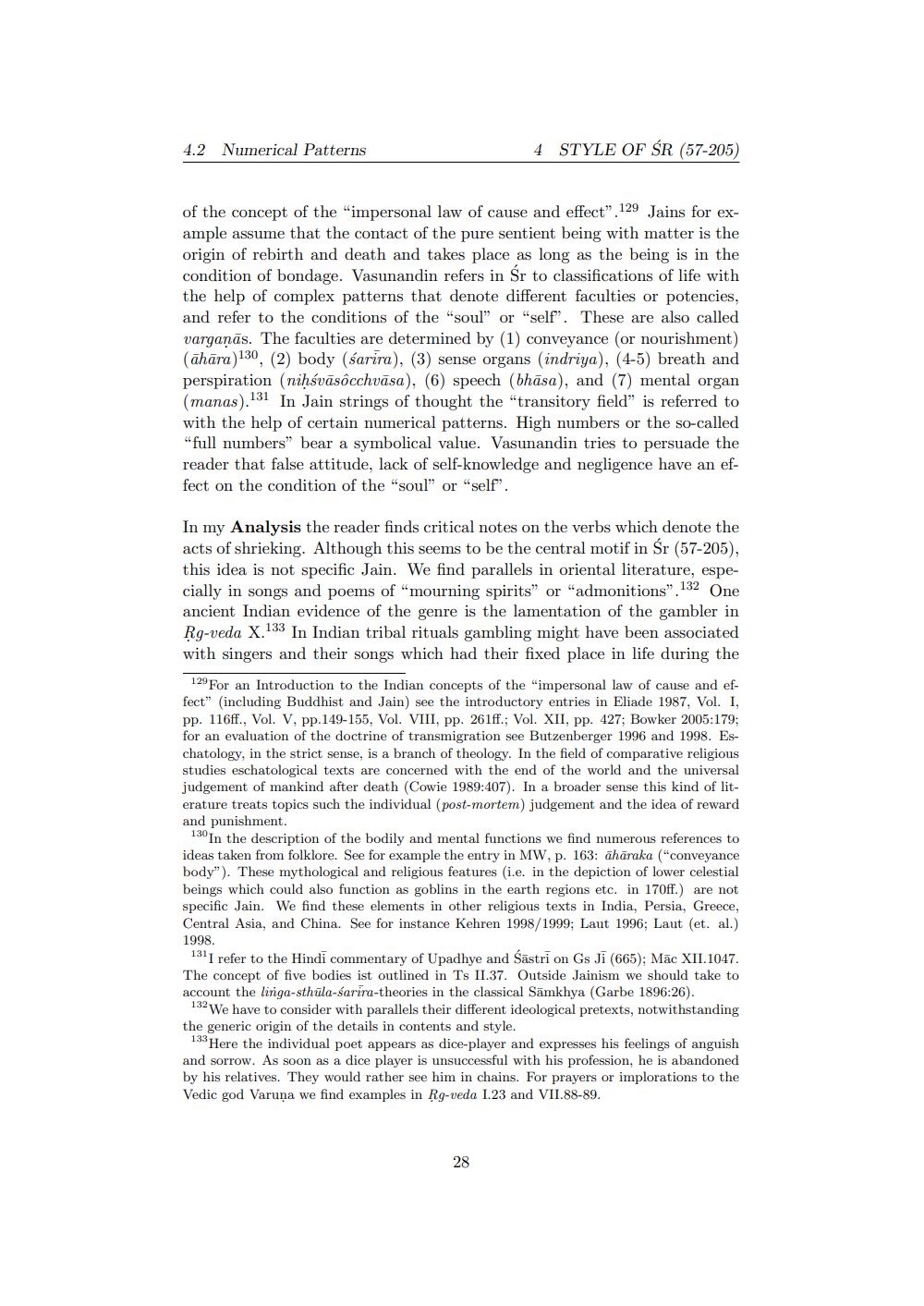________________
4.2 Numerical Patterns
4 STYLE OF ŚR (57-205)
of the concept of the "impersonal law of cause and effect". 129 Jains for example assume that the contact of the pure sentient being with matter is the origin of rebirth and death and takes place as long as the being is in the condition of bondage. Vasunandin refers in Sr to classifications of life with the help of complex patterns that denote different faculties or potencies, and refer to the conditions of the "soul" or "self". These are also called varganās. The faculties are determined by (1) conveyance (or nourishment) (ahāra) 130, (2) body (sarira), (3) sense organs (indriya), (4-5) breath and perspiration (nihśvāsôcchvāsa), (6) speech (bhāsa), and (7) mental organ (manas).131 In Jain strings of thought the "transitory field" is referred to with the help of certain numerical patterns. High numbers or the so-called "full numbers" bear a symbolical value. Vasunandin tries to persuade the reader that false attitude, lack of self-knowledge and negligence have an effect on the condition of the "soul" or "self".
In my Analysis the reader finds critical notes on the verbs which denote the acts of shrieking. Although this seems to be the central motif in Śr (57-205), this idea is not specific Jain. We find parallels in oriental literature, especially in songs and poems of “mourning spirits” or “admonitions". 132 One ancient Indian evidence of the genre is the lamentation of the gambler in Rg-veda X.133 In Indian tribal rituals gambling might have been associated with singers and their songs which had their fixed place in life during the
129 For an Introduction to the Indian concepts of the "impersonal law of cause and effect" (including Buddhist and Jain) see the introductory entries in Eliade 1987, Vol. I, pp. 116ff., Vol. V, pp.149-155, Vol. VIII, pp. 261ff., Vol. XII, pp. 427; Bowker 2005:179: for an evaluation of the doctrine of transmigration see Butzenberger 1996 and 1998. Eschatology, in the strict sense, is a branch of theology. In the field of comparative religious studies eschatological texts are concerned with the end of the world and the universal judgement of mankind after death (Cowie 1989:407). In a broader sense this kind of literature treats topics such the individual (post-mortem) judgement and the idea of reward and punishment.
130 In the description of the bodily and mental functions we find numerous references to ideas taken from folklore. See for example the entry in MW, p. 163: āhāraka (“conveyance body"). These mythological and religious features (i.e. in the depiction of lower celestial beings which could also function as goblins in the earth regions etc. in 170ff.) are not specific Jain. We find these elements in other religious texts in India, Persia, Greece, Central Asia, and China. See for instance Kehren 1998/1999; Laut 1996; Laut (et. al.) 1998.
131 I refer to the Hindi commentary of Upadhye and Šāstri on Gs Ji (665); Māc XII.1047. The concept of five bodies ist outlined in Ts II.37. Outside Jainism we should take to account the linga-sthūla-sarira-theories in the classical Sāmkhya (Garbe 1896:26).
132 We have to consider with parallels their different ideological pretexts, notwithstanding the generic origin of the details in contents and style.
133 Here the individual poet appears as dice-player and expresses his feelings of anguish and sorrow. As soon as a dice player is unsuccessful with his profession, he is abandoned by his relatives. They would rather see him in chains. For prayers or implorations to the Vedic god Varuna we find examples in Rg-veda I.23 and VII.88-89.
28




